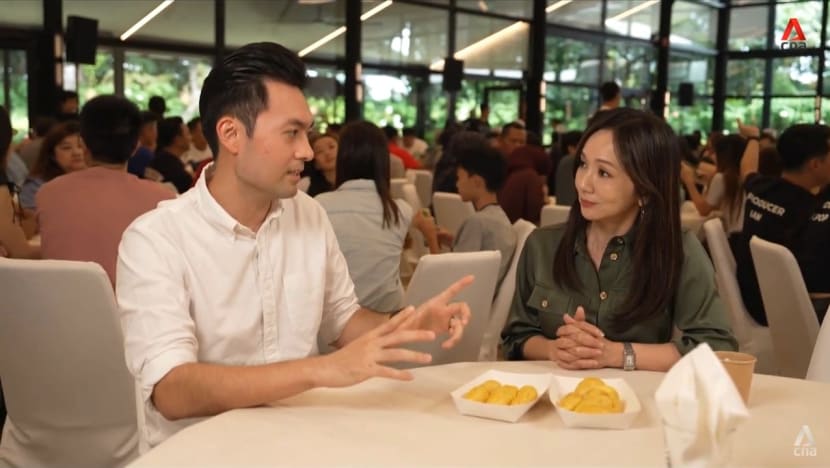New thorns in town? Here’s why Tupai King, other new durian varieties may be mislabelled
In each durian season, flashy names beckon customers. But are they the real deal or simply marketing ploys? The programme Talking Point finds out what durians are really being sold and how to avoid falling for thorny cash grabs.

The Tupai King durian. But there’s very little chance you’d get the real deal in Singapore for now.

This audio is generated by an AI tool.
SINGAPORE: In the kingdom of fruits, the durian reigns supreme. But within its own ranks, there is no shortage of contenders vying for the season’s crown.
Few fruits boast such an array of commercially available varieties, from Mao Shan Wang to D24 to Red Prawn, as the durian.
Lately, it is newcomers like Tupai King and Black Thorn that have shaken up the market, at prices that could be 50 to 90 per cent higher than classics like Mao Shan Wang.
These new varieties have puzzled durian enthusiast Andrew Yeo, who has indulged in the spiky fruit nearly twice a week this season.
He paid S$28 per kilogramme for Tupai King, the most he has shelled out so far. But he noticed that one shop sale sign saying “Tupai King” also had “Mao Shan Wang” written underneath.

“What am I actually paying for? And when I speak to different durian sellers, they give me different answers,” he said. “I suspect (these new varieties) could be part of the same cultivar … just that (they’re) being mislabelled.”
While each variety promises unique flavours and textures, are these new names part of a marketing gimmick or genuine varieties? The programme Talking Point enlists the help of durian experts to investigate whether what’s being sold is truly as advertised.
DOES SINGAPORE REALLY HAVE TUPAI KING?
Tupai King, or Squirrel King, is the newest variety on the scene, with a buzz about the durian emerging on social media and online forums around three years ago.
What sets this genus apart is its slim, oval shape and the method of opening it. Typically, durians are opened from the bottom, but Tupai King is opened from the top, where its skin is thinner compared to its bottom.

In terms of taste, it is more bitter and less sweet than the popular Mao Shan Wang. It also sports a slightly bruised, greenish flesh, even without much fermentation.
“The special thing is, when I finish the whole durian, there’s like an alcoholic taste,” said Talking Point host Diana Ser, who travelled to Penang for a tasting in 56-year-old Chew Chee Wan’s durian shop, Cap Tupai.
Chew, who was the first to cultivate the Tupai King and has a certificate from the Malaysian Agricultural Research and Development Institute proving that he registered the name, does not even display his signature durian in his shop.
It is too precious and scarce, with about a thousand produced each season — whilst Singapore’s total durian imports from Malaysia in peak season, which include Mao Shan Wang, is around 100 tonnes a day.
WATCH: New ‘premium’ durian varieties — Are they just Mao Shan Wang remarketed? (23:28)
“Out of 10 durians, maybe only one is (that) of the rarer variety,” said Kelvin Tan, the owner of Singaporean durian shop 99 Old Trees, who has yet to taste Tupai King himself.
The rarity of Tupai King drives up its price. Chew sells it at RM120/kg, which works out at around S$110 for a 3-kg durian.
And the reason for its rarity is that there are not many fruiting trees. He started promoting Tupai King and selling the durian saplings only in 2022. He also shared seedlings with a few farmer friends, which have not yielded fruit yet.
“Fruits that are grafted on old trees can bear fruits after three and a half years, and the fruits produced are of high quality,” said Chew, who has an 8.5-acre plantation and who grafted his first trees in 2004.

Based on the rate of cultivation, experts estimate that it will take five to 10 years for the Singapore market to savour the taste of Tupai King.
Are the ones popping up in Singapore the real deal, then? “I dare say the Tupai King that’s found in Singapore isn’t my authentic Tupai King,” he said. “Because my Tupai King hasn’t been exported to Singapore.”
THE TRUTH BEHIND PREMIUM VARIANTS
What, then, have Singaporean durian lovers such as Yeo been buying and eating? To find out, Ser had five durian experts put some Tupai King from a local stall — costing S$58/kg — to the test.
A couple of them quickly identified the fruit as Mao Shan Wang rather than Tupai King owing to its deep yellow flesh.

Former durian seller Loh Dewei, with 18 years’ experience, also said the durians’ flat, dark brown seeds were characteristic of Mao Shan Wang.
This case of mislabelling is not an isolated incident. Another durian, sold to Ser as “Old Tree” for around S$18/kg, was revealed to be a Thai Chanee durian — harvested when it falls to the ground rather than from the tree.
The classification “Old Tree” itself is contentious. Ser learnt in Penang that durians are not typically sorted by their tree age, which makes it “highly unlikely” that sellers can distinguish between durians from old trees and others.
Black Gold, King of Kings and even Old Tree are often just elaborate names for variations on Mao Shan Wang.

“Mao Shan Wang has a very wide taste profile, (from) quite sweet to the very bitter type,” said David Loh, the former durian seller behind My Durian Hubz on Facebook.
“Vendors have leveraged this opportunity to market (Mao Shan Wang) as various types.”
Josiah Seow, the founder of durian company Golden Moments, agreed that these were marketing strategies to increase profit margins and possibly “create some confusion”, though he did not see anything inherently wrong with that.
For instance, a fully ripe Mao Shan Wang with some bruising might be called Black Gold, while a more fermented one could be labelled “Old Tree”. Nonetheless, he held that sellers should be honest when customers inquire about these differences.
Over the years, terms such as “Black Gold” have also been loosely used to create certain expectations about flavour and drive demand, observed Loh Dewei.
Yet, there is inconsistency. One seller might label a strong, bitter durian “Black Gold”, while another might do the same with an ordinary Mao Shan Wang.
Sellers who disregard the flavour profiles simply want to mark up the price, added Loh Dewei.
THE FIVE S’S OF BUYING DURIAN
So how can durian lovers avoid thorny cash grabs?
Yeo advised buying the fruit from reputable sellers to minimise the risk of receiving stale or misrepresented durians, while Tan suggested that buyers do their homework to recognise the appearance of different cultivars.

Tan also warned that online scams are more prevalent because hardly anything might be known about the seller. To protect oneself, one can look for sellers with a high volume of reviews.
When buying durians in person, one can keep the five S’s in mind:
First, choose a durian in the 1.7 to 2.2 kg range, as larger-sized ones tend to be overripe. Next, perform the stem test: A green stem means freshness. Then, look for signs of spoilage, such as a deep horizontal crack.
Afterwards, shake the durian gently to assess its sound. A loud knocking suggests the flesh is overripe, a gentler sound indicates ripeness and no sound at all signals that it is unripe.
Finally, use your sense of smell. A ripe durian will have a strong — some say pleasant — aroma; an unripe one will have little to no smell.
To save some money and avoid the hype, take a page from Yeo’s updated durian playbook: Go for Mao Shan Wang, and embrace the natural variance in each fruit.
Watch this episode of Talking Point here. The programme airs on Channel 5 every Thursday at 9:30 p.m.



















